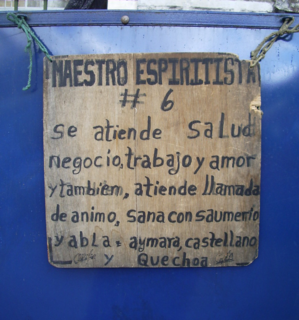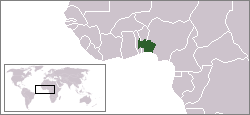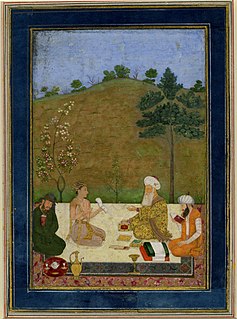 W
WThe AllatRa International Public Movement is a Kyiv-based group founded in 2011 that promotes a self-published book named AllatRa. There seems to be a debate among some religious scholars in the Russosphere on whether AllatRa is a religious organization, with some researchers classify ALLATRA as a new religious movement with characteristics of syncreticism, Apocalypticism, Pan-Slavism, New Thought and New Age. The organization itself has responded that it is not New Age, but rather claims to be based on "old but renewed true knowledge".
 W
WCandomblé is an African diasporic religion that developed in Brazil during the 19th century. It arose through a process of syncretism between the traditional religions of West Africa and the Roman Catholic form of Christianity. There is no central authority in control of Candomblé, which is organised through autonomous groups.
 W
WThe Dīn-i-Ilāhī, known during its time as Tawḥīd-i-Ilāhī or Divine Faith was a syncretic religion propounded by the Mughal emperor Akbar in 1582, intending to merge some of the elements of the religions of his empire, and thereby reconcile the differences that divided his subjects. The elements were primarily drawn from Islam, Hinduism, and Zoroastrianism, but some others were also taken from Christianity, Jainism, and Buddhism.
 W
WEspiritismo is a term used in Latin America and the Caribbean to refer to the popular belief that good and evil spirits can affect health, luck and other aspects of human life.
 W
WGreco-Buddhism, or Graeco-Buddhism, is the cultural syncretism between Hellenistic culture and Buddhism, which developed between the fourth century BCE and the fifth century CE in Bactria and the Indian subcontinent. It was a cultural consequence of a long chain of interactions begun by Greek forays into India from the time of Alexander the Great. The Macedonian satraps were then conquered by the Mauryan Empire, under the reign of Chandragupta Maurya. The Mauryan Emperor Ashoka would convert to Buddhism and spread the religious philosophy throughout his domain, as recorded in the Edicts of Ashoka.
 W
WThe Han Kitab was a collection of Chinese Islamic texts, written by Chinese Muslims, which synthesized Islam and Confucianism. It was written in the early 18th century during the Qing dynasty. Its name is similarly synthesised: 'Han' is the Chinese word for Chinese, and 'kitab' means book in Arabic. Liu Zhi wrote his Han Kitab in Nanjing in the early 18th century. The works of Wu Zunqie, Zhang Zhong, and Wang Daiyu were also included in the Han Kitab.
 W
WInterpretatio graeca or "interpretation by means of Greek [models]" is a discourse used to interpret or attempt to understand the mythology and religion of other cultures; a comparative methodology using ancient Greek religious concepts and practices, deities, and myths, equivalencies, and shared characteristics.
 W
WMajma-ul-Bahrain is a book on comparative religion authored by Mughal Shahzada Dara Shukoh as a short treatise in Persian, c. 1655. It was devoted to a revelation of the mystical and pluralistic affinities between Sufic and Vedantic speculation. It was one of the earliest works to explore both the diversity of religions and a unity of Islam and Hinduism and other religions. Its Hindi version is called Samudra Sangam Grantha and an Urdu translation titled Nūr-i-Ain was lithographed in 1872.
 W
WMegasthenes' Herakles is the conventional name of an ancient Indian deity referred to by Greek sources such as Megasthenes. According to Arrian, Diodorus, and Strabo, Megasthenes described an Indian tribe called Sourasenoi, who especially worshipped Herakles in their land. Although Hercules belonged to the classical Greek pantheon, the ancient Greeks commonly described foreign gods in terms of their own divinities. Therefore it is highly likely that the divinity was referring to Krishna or his brother Balarama. The historian Quintus Curtius Rufus mentions that when Alexander the Great confronted Porus on the battlefield, the soldiers in the vanguard of Porus' army were flying banners containing the image of 'Herakles'. This can either be referring to images of Krishna or Balarama, or a transcreation of the term Hari-Krishna. In the Maurya era, Megasthenes travelled to India as the ambassador of the Seleucids during the reign of Chandragupta Maurya. Upon visiting Mathurai of the Early Pandyan Kingdom, he described the kingdom as being named after Pandaea, Herakles' only daughter. However this is most likely a misinterpretation, as the Pandyan Kingdom did have prior contact with the Greeks nor did they use an Indo-European language.
 W
WThe Moorish Science Temple of America is an American national and religious organization founded by Noble Drew Ali. He based it on the premise that African Americans are descendants of the Moabites and thus are "Moorish" by nationality, and Islamic by faith. Ali put together elements of major traditions to develop a message of personal transformation through historical education, racial pride and spiritual uplift. His doctrine was also intended to provide African Americans with a sense of identity in the world and to promote civic involvement.
 W
WThe Native American Church (NAC), also known as Peyotism and Peyote Religion, is a Native American religion that teaches a combination of traditional Native American beliefs and Christianity, with sacramental use of the entheogen peyote. The religion originated in the Oklahoma Territory (1890-1907) in the late nineteenth century, after peyote was introduced to the southern Great Plains from Mexico. Today it is the most widespread indigenous religion among Native Americans in the United States, Canada, and Mexico, with an estimated 250,000 adherents as of the late twentieth century.
 W
WChrislam refers to the assemblage of Christian and Islamic religious practices in Nigeria; in particular, the series of religious movements that merged Christian and Islamic religious practice during the 1970s in Lagos, Nigeria. The movement was pioneered by Yoruba peoples in south-west Nigeria. Chrislam works against the conventional understanding of Christianity and Islam as two separate and exclusive religions, seeking out commonalities between both religions and promoting an inclusive union of the two. Chrislam also occupies a distinct geographical space; Nigeria is often understood to be geographically and religiously polarized, with a predominantly Christian base in the South, and a Muslim base in the North. However, the Yoruba peoples that occupy the South-Western Yorubaland region of Nigeria are almost evenly divided between Christian and Muslim populations.
 W
WThe Nuwaubian Nation or Nuwaubian movement is an American religious group founded and led by Dwight York, also known as Malachi Z. York. York began founding Black Muslim groups in New York in 1967. He changed his teachings and the names of his groups many times, incorporating concepts from Judaism, Christianity, and many esoteric beliefs.
 W
WThe Pompeii Lakshmi is an ivory statuette that was discovered in the ruins of Pompeii, which was destroyed in the eruption of Mount Vesuvius 79 CE. She was found by Amedeo Maiuri, an Italian scholar in 1938. The statuette has been dated to the first-century CE. The statuette is thought of as representing an Indian goddess of feminine beauty and fertility. It is possible that the sculpture originally formed the handle of a mirror. The Lakshmi is evidence of commercial trade between India and Italy in the first century CE.
 W
WThe Sirr-i-Akbar is a version of the Upanishads authored by the Mughal-Shahzada, Dara Shukoh, translated from Sanskrit into Persian, c. 1657. After years of Sufi learning, Dara Shukoh sought to uncover a common mystical language between Islam and Hinduism, boldly stating that the Kitab al-Maknun, or "Hidden Book", mentioned in the Qur'an is none other than the Upanishads.
 W
WUnitarian Universalism (UU) is a liberal religion characterized by a "free and responsible search for truth and meaning". Unitarian Universalists assert no creed, but instead are unified by their shared search for spiritual growth, guided by a dynamic, "living tradition". Currently, these traditions are summarized by the Six Sources and Seven Principles of Unitarian Universalism, documents recognized by all congregations who choose to be a part of the Unitarian Universalist Association. These documents are 'living', meaning always open for revisiting and reworking. Unitarian Universalist (U.U.) congregations include many atheists, agnostics, and theists within their membership—and there are U.U. churches, fellowships, congregations, and societies around the world. The roots of Unitarian Universalism lie in liberal Christianity, specifically unitarianism and universalism. Unitarian Universalists state that from these traditions comes a deep regard for intellectual freedom and inclusive love. Congregations and members seek inspiration and derive insight from all major world religions.
 W
WThe Yoruba religion comprises the traditional religious and spiritual concepts and practice of the Yoruba people. Its homeland is in present-day Southwestern Nigeria which comprised Oyo, Ogun, Osun, Ondo, Ekiti, and Kwara as well as Lagos States, parts of Kogi state and the adjoining parts of Benin and Togo, commonly known as Yorubaland. It shares some parallels with the Vodun practiced by the neighboring Fon and Ewe peoples to the west and to the religion of the Edo people to the east. Yoruba religion is the basis for a number of religions in the New World, notably Santería, Umbanda, Trinidad Orisha, Haitian Vodou, and Candomblé. Yoruba religious beliefs are part of Itàn (history), the total complex of songs, histories, stories, and other cultural concepts which make up the Yoruba society.